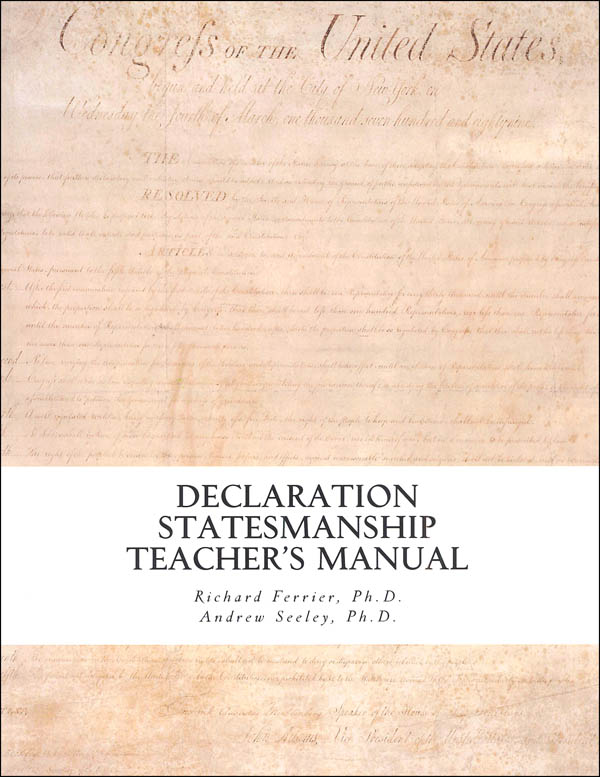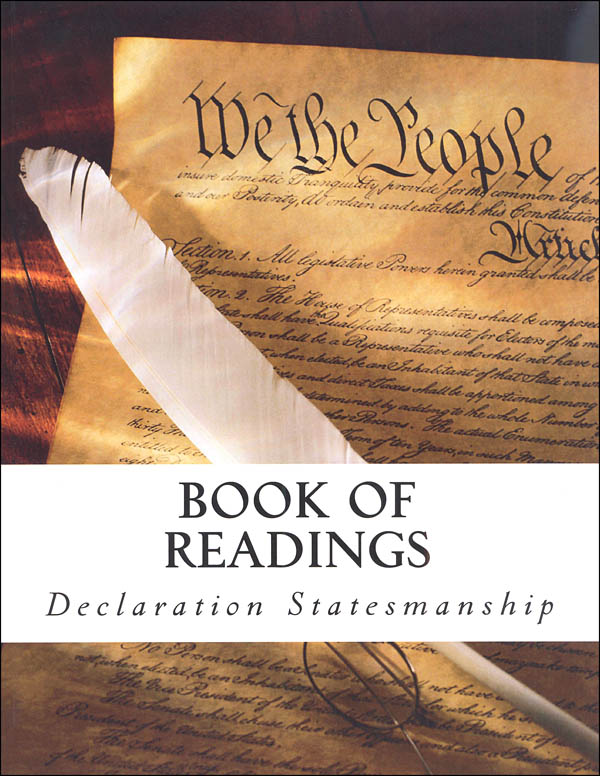Since the last review of this work, the name has changed, and it now comes with a teacher's manual and book of readings. It was formerly called America's Declaration Principles in Thought and Action. The main text has not changed, but is now printed in an attractive 8 X 11 comb-bound book.
Original Review:
The stated purpose of America's Declaration Principles in Thought and Action, a text for use by high school students, is to, " . . . help the young citizens of America to understand how the principles of the American founding are crucial to the pursuit of happiness which is their birthright." The text follows the thought and development of the Declaration as the founding document of our country and then traces its spirit through two centuries of application in the political life of the country. The book is only nine chapters and 154 pages, but it is packed full of extension ideas, suggestions for further reading and thoughtful reflections that would easily fill a year's civics course.
The format of the book is very straightforward and the text quite readable, even enjoyable. What makes this book exceptional in the world of high school history publishing are the suggestions for further reading, questions for reflection and possible extra study or writing assignments given in each chapter, sometimes several times in a chapter. ALL of these suggestions are at higher levels of thinking which require the student to reflect, analyze, compare, critique and draw conclusions. This is truly a text to challenge and refine thinking skills while studying an essential topic in today's world.
Here is an example of a question from the "for reflection and research" section of Chapter 5 (which examines the Declaration in detail): "In a certain way, it was easier for the founders to see that they were serving in a high cause, an honorable one, in the revolution, than it is for us to see that we are doing something similar in performing our civic duty today. More seems to be demanded of a man to stand up to a line of British Grenadiers that to decide rightly on a school bond issue, or to obey the zoning laws of his county. What else might lead us to deny the honorable character of public service in our time? What can be said in defense of it? Lincoln will consider, in a famous speech he gave as a young man, in 1838, the different challenges facing the founding generation and a generation whose task is to preserve the Republic. What do you think are the threats to liberty today, and what virtues and knowledge are necessary to defeat them?"
I quite honestly have never seen anything like this.
In addition, at the end of each chapter is an outline of the chapter which would be a great study aid for review or help students organize their basic comprehension of the material.
So what about the content? The authors assert that the Declaration, as the founding document of the country, is the "spirit of the law" beneath the "letter of the law," the Constitution. So we should read/interpret the Constitution in the light of the Declaration. To do this we must understand the Declaration first. So that is where the book begins. Chapter One makes the argument that our country began, not with the end of the war, not with the Constitution, but with the Declaration. So its first principles are the first principles of our country. Chapter Two describes some of the history of political thought which led the colonists to believe that they had a right to rule themselves. Chapter Three is the Declaration itself. Chapter 4, entitled "The roots of American Liberty," discusses the sources of the idea of democracy throughout history. Sources quoted include ancient philosophers, such as Aristotle and Cicero, more modern philosophers, such as John Locke, several colonial period clergymen and a Catholic saint.
Chapter 5 examines the Declaration in detail and contains some excellent suggestions for thinking and research. Chapter 6, divided into two parts, examines the Articles of Confederation and the Constitution. Direct correlation is made between the complaints listed in the Declaration and the wording of the Constitution. Chapter 7 picks up the subject of slavery as the great stain on the American experiment and as a test of the founding principles of our country. By the standard of the Declaration, we - the courts, the courts, the Congress, and, according to the authors, the policy of the founders - failed.
Chapter 8 begins a treatment of the kind of statesmanship that a true adherence to the Declaration would produce. It begins with Lincoln. This chapter is the most lengthy and the most challenging of the book. It traces the history of the pre-Civil War era and then the effects of reconstruction in the South leading up to the civil right efforts in the Sixties. Chapter 9, in the authors' own words, " . . . investigate(s) the characteristics that have made our country the most successful democracy in history." The authors explore Alexis deTocqueville's writings and offer modern day commentary on what he reported. In the section on education, the authors claim, " To act well, to achieve good, a good hearted American student needs to understand the principles that have made his country." This seems very basic and is perhaps one objective of every American history course in every school in the country. This book, however, gives the student the chance of truly doing that.
The text and assignments are challenging. This is not the kind of book you could just hand to a 16 year old and say, "go to your room and do this." Most students will need guidance to select the extra activities and help to find the suggested readings. It also begs discussion, and the best situation, perhaps, would be to have a group of home schooling students come together to discuss it. Some of the chapter questions require knowledge of the history of the United States, so it would be good to do this course after or coinciding with a history course. To make a more involved course, a student could research the historical part as he goes along.
The correlation of the primary source readings makes this program unique and fills a great need in home schooling curriculum.
More Updates to the Original Review:
 The Teacher's Manual is 68 pages and divided in four parts: lessons plans for a 14 week semester course; answer keys to the review questions in the Course the book of readings; ready-made quizzes and tests (with their answers); and teaching strategies. This helps tremendously in seeing the view of the course that the authors intend. The teaching strategies section is especially helpful. In it, the authors explain their purpose and goal for each chapter and give more background information and teaching tips for the teacher.
The Teacher's Manual is 68 pages and divided in four parts: lessons plans for a 14 week semester course; answer keys to the review questions in the Course the book of readings; ready-made quizzes and tests (with their answers); and teaching strategies. This helps tremendously in seeing the view of the course that the authors intend. The teaching strategies section is especially helpful. In it, the authors explain their purpose and goal for each chapter and give more background information and teaching tips for the teacher.
 The Readings book is a 127 page collection of primary works that the student reads as part of the course. The authors have also thoughtfully included comprehension and discussion questions for each reading. Not all the readings required for the course are published in this volume, but most of the American sources are. For all other works needed, (mostly the ancient sources), the authors have listed web pages where they may be found. When I first reviewed this course, I thought that even though it was excellent, the finding of all these primary sources would be daunting for a homeschool family. This book of readings solves that problem!
The Readings book is a 127 page collection of primary works that the student reads as part of the course. The authors have also thoughtfully included comprehension and discussion questions for each reading. Not all the readings required for the course are published in this volume, but most of the American sources are. For all other works needed, (mostly the ancient sources), the authors have listed web pages where they may be found. When I first reviewed this course, I thought that even though it was excellent, the finding of all these primary sources would be daunting for a homeschool family. This book of readings solves that problem!
After reading this course a second time, I remain convinced that there is nothing like it!
Recommended for a semester Civics course for 11th or 12th grade.
